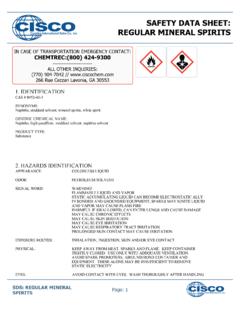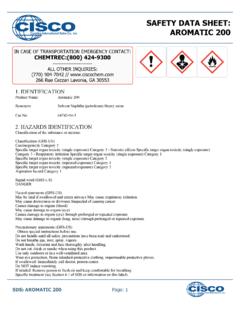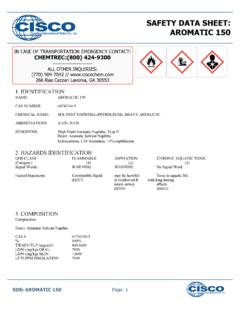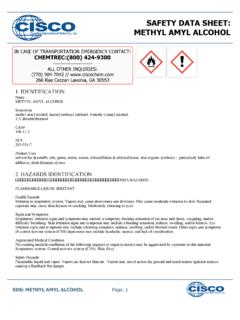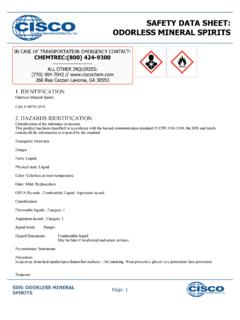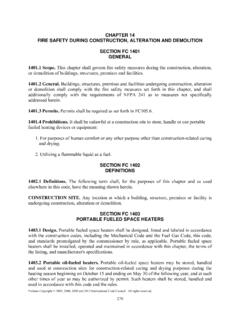Transcription of SAFETY DATA SHEET: TRIETHYLENE GLYCOL
1 SAFETY DATA SHEET: TRIETHYLENE GLYCOL . IN CASE OF TRANSPORTATION EMERGENCY CONTACT: CHEMTREC:(800) 424-9300. ----------------------- ALL OTHER INQUIRIES: (770) 904-7042 // 266 Rue Cezzan Lavonia, GA 30553. 1. IDENTIFICATION. PRODUCT NAME: TRIETHYLENE GLYCOL . CAS NO: 112-27-6. SYNONYM: 2,2'-[ETHANEDIYLBIS(OXY)]BISETHANOL. 2. HAZARDS IDENTIFICATION. Potential Acute Health Effects: Very hazardous in case of eye contact (irritant), of ingestion. Slightly hazardous in case of inhalation. Inflammation of the eye is characterized by redness, watering, and itching. Potential Chronic Health Effects: Very hazardous in case of eye contact (irritant). Slightly hazardous in case of inhalation. CARCINOGENIC EFFECTS: Not available. MUTAGENIC EFFECTS: Not available. TERATOGENIC EFFECTS: Not available. DEVELOPMENTAL TOXICITY: Not available. The substance is toxic to kidneys, the nervous system. Repeated or prolonged exposure to the substance can produce target organs damage.
2 Aspiration hazard: Based on physical properties, not likely to be an aspiration hazard. Effects of Repeated Exposure: Based on available data, repeated exposures are not expected to cause significant adverse effects except at very high aerosol concentrations. Repeated excessive aerosol exposures may cause respiratory tract irritation and even death. Birth Defects/Developmental Effects: TRIETHYLENE GLYCOL did not cause birth defects in animals; reduced fetal body weight effects were seen only at very high doses. 3. COMPOSITION. NAME: CAS NO % BY WEIGHT. TRIETHYLENE GLYCOL 112-27-6 100%. Toxicological Data on Ingredients: TRIETHYLENE GLYCOL : ORAL (LD50): Acute: 17000 mg/kg [Rat]. 4. FIRST AID MEASURES. Eye Contact: Flush eyes thoroughly with water for several minutes. Remove contact lenses after the initial 1-2 minutes and continue flushing for several additional minutes. If effects occur, consult a physician, preferably an ophthalmologist. Skin Contact: Immediately flush skin with water while removing contaminated clothing and shoes.
3 Get medical attention if symptoms occur. Wash clothing before reuse. Destroy contaminated leather items such as shoes, belts, and watchbands. SAFETY SDS: TRIETHYLENE GLYCOL Page: 1. shower should be located in immediate work area. Inhalation: Move person to fresh air; if effects occur, consult a physician. Ingestion: Do not induce vomiting. Seek medical attention immediately. If person is fully conscious give 1 cup or 8 ounces (240 ml). of water. If medical advice is delayed and if an adult has swallowed several ounces of chemical, then give 3-4 ounces (1/3-1/2 Cup). (90-120 ml) of hard liquor such as 80 proof whiskey. For children, give proportionally less liquor at a dose of ounce (1 1/2 tsp.). (8 ml) liquor for each 10 pounds of body weight, or 2 ml per kg body weight [ , ounce (2 1/3 tbsp.) for a 40 pound child or 36. ml for an 18 kg child]. Notes to Physician: Due to structural analogy and clinical data, this material may have a mechanism of intoxication similar to ethylene GLYCOL .
4 On that basis, treatment similar to ethylene GLYCOL intoxication may be of benefit. In cases where several ounces (60. - 100 ml) have been ingested, consider the use of ethanol and hemodialysis in the treatment. Consult standard literature for details of treatment. If ethanol is used, a therapeutically effective blood concentration in the range of 100 - 150 mg/dl may be achieved by a rapid loading dose followed by a continuous intravenous infusion. Consult standard literature for details of treatment. 4-Methyl pyrazole (Antizol ) is an effective blocker of alcohol dehydrogenase and should be used in the treatment of ethylene GLYCOL (EG), di- or TRIETHYLENE GLYCOL (DEG, TEG), ethylene GLYCOL butyl ether (EGBE), or methanol intoxication if available. Fomepizole protocol (Brent, J. et al., New England Journal of Medicine, Feb. 8, 2001, 344:6, p. 424-9): loading dose 15 mg/kg intravenously, follow by bolus dose of 10 mg/kg every 12 hours; after 48 hours, increase bolus dose to 15 mg/kg every 12 hours.
5 Continue fomepizole until serum methanol, EG, DEG, TEG or EGBE are undetectable. The signs and symptoms of poisoning include anion gap metabolic acidosis, CNS depression, renal tubular injury, and possible late stage cranial nerve involvement. Respiratory symptoms, including pulmonary edema, may be delayed. Persons receiving significant exposure should be observed 24-48 hours for signs of respiratory distress. In severe poisoning, respiratory support with mechanical ventilation and positive end expiratory pressure may be required. Maintain adequate ventilation and oxygenation of the patient. If lavage is performed, suggest endotracheal and/or esophageal control. Danger from lung aspiration must be weighed against toxicity when considering emptying the stomach. If burn is present, treat as any thermal burn, after decontamination. Treatment of exposure should be directed at the control of symptoms and the clinical condition of the patient. Emergency Personnel Protection: First Aid responders should pay attention to self-protection and use the recommended protective clothing (chemical resistant gloves, splash protection).
6 If potential for exposure exists refer to Section 8 for specific personal protective equipment. 5. fire FIGHTING MEASURES. Extinguishing Media: Water fog or fine spray. Dry chemical fire extinguishers. Carbon dioxide fire extinguishers. Foam. Do not use direct water stream. May spread fire . Alcohol resistant foams (ATC type) are preferred. General purpose synthetic foams (including AFFF) or protein foams may function, but will be less effective. fire Fighting Procedures: Keep people away. Isolate fire and deny unnecessary entry. Use water spray to cool fire exposed containers and fire affected zone until fire is out and danger of reignition has passed. Fight fire from protected location or safe distance. Consider the use of unmanned hose holders or monitor nozzles. Immediately withdraw all personnel from the area in case of rising sound from venting SAFETY device or discoloration of the container. Burning liquids may be extinguished by dilution with water.
7 Do not use direct water stream. May spread fire . Move container from fire area if this is possible without hazard. Burning liquids may be moved by flushing with water to protect personnel and minimize property damage. Special Protective Equipment for Firefighters: Wear positive-pressure self-contained breathing apparatus (SCBA) and protective fire fighting clothing (includes fire fighting helmet, coat, trousers, boots, and gloves). If protective equipment is not available or not used, fight fire from a protected location or safe distance. Unusual fire and Explosion Hazards: Container may rupture from gas generation in a fire situation. Violent steam generation or eruption may occur upon application of direct water stream to hot liquids. Hazardous combustion Products: During a fire , smoke may contain the original material in addition to combustion products of varying composition which may be toxic and/or irritating. combustion products may include and are not limited to: Carbon monoxide.
8 Carbon dioxide. 6. ACCIDENTAL RELEASE MEASURES. SDS: TRIETHYLENE GLYCOL Page: 2. Steps to be Taken if Material is Released or Spilled: Small spills: Absorb with materials such as: Dirt. Sand. Sawdust. Vermiculite. Perlite. Zorb-all . Oil-Dri or equivalent filler. Large spills: Dike area to contain spill. Pump into suitable and properly labeled containers. See Section 13, Disposal Considerations, for additional information. Personal Precautions: Keep unnecessary and unprotected personnel from entering the area. Use appropriate SAFETY equipment. For additional information, refer to Section 8, Exposure Controls and Personal Protection. Environmental Precautions: Prevent from entering into soil, ditches, sewers, waterways and/or groundwater. See Section 12, Ecological Information. 7. HANDLING AND STORAGE. Handling General Handling: Avoid contact with skin and clothing. Wash thoroughly after handling. Spills of these organic materials on hot fibrous insulations may lead to lowering of the autoignition temperatures possibly resulting in spontaneous combustion .
9 See Section 8, EXPOSURE CONTROLS AND PERSONAL PROTECTION. Storage Do not store near food, foodstuffs, drugs or potable water supplies. Additional storage and handling information on this product may be obtained by calling your sales or customer service contact. 8. EXPOSURE CONTROLS AND PERSONAL PROECTION. Component List Type Value TRIETHYLENE GLYCOL IHG TWA Total 100 mg/m3. Personal Protection Eye/Face Protection: Use SAFETY glasses (with side shields). If there is a potential for exposure to particles which could cause eye discomfort, wear chemical goggles. Skin Protection: When prolonged or frequently repeated contact could occur, use protective clothing chemically resistant to this material. Selection of specific items such as faceshield, boots, apron, or full-body suit will depend on the task. When handling hot material, protect skin from thermal burns as well as from skin absorption. Hand protection: Use gloves chemically resistant to this material when prolonged or frequently repeated contact could occur.
10 If hands are cut or scratched, use gloves chemically resistant to this material even for brief exposures. Use gloves with insulation for thermal protection, when needed. Examples of preferred glove barrier materials include: Butyl rubber. Natural rubber ("latex"). Neoprene. Nitrile/butadiene rubber ("nitrile" or "NBR"). Polyethylene. Ethyl vinyl alcohol laminate ("EVAL"). Polyvinyl alcohol ("PVA"). Polyvinyl chloride ("PVC" or "vinyl"). NOTICE: The selection of a specific glove for a particular application and duration of use in a workplace should also take into account all relevant workplace factors such as, but not limited to: Other chemicals which may be handled, physical requirements (cut/puncture protection, dexterity, thermal protection), potential body reactions to glove materials, as well as the instructions/specifications provided by the glove supplier. Respiratory Protection: Respiratory protection should be worn when there is a potential to exceed the exposure limit requirements or guidelines.
